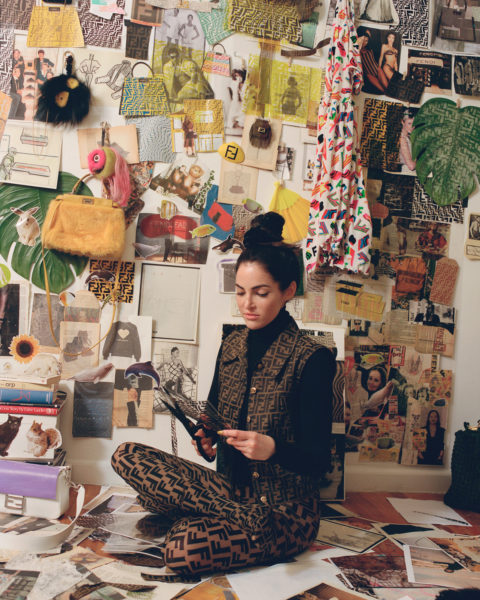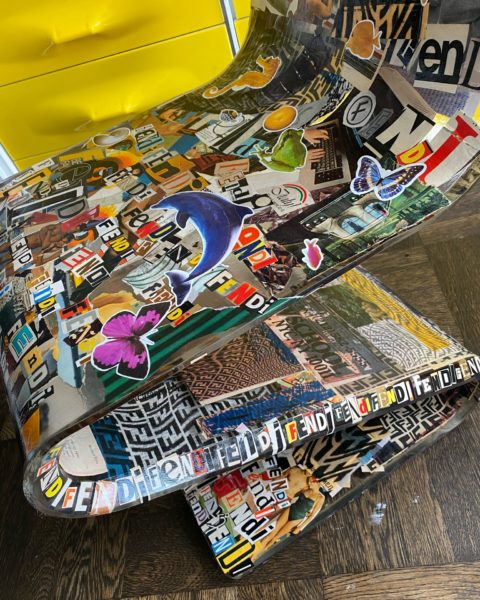Here’s How New York Artist Sarah Coleman Reimagined Fendi’s Iconic Logo
"I really enjoy working with logos because there's something so powerful about the way they can stand the test of time, whether the logo has been around 25 years or 100 years."
When Sarah Coleman, a visual artist based in New York, was asked to redesign the Fendi store in Miami, the only instruction she received was: “be disruptive.” She ran with it, printing archival brand imagery onto vintage magazine paper to collage a chair, designing a glow-in-the-dark handbag, and manipulating Fendi’s iconic prints by running them through the Facetune editing app.
“I always see objects as very transformative in use; I don’t always use [them] the way that one is supposed to,” Coleman tells FASHION. “I like the idea of having a purse that can be used as a pillow if you need. If you get rid of the boxes and meanings society has placed so rigidly upon objects, anything can be repurposed into anything. Some people are afraid of being laughed at for using an object in a way that is considered wrong, but I prefer to embrace the laughter and forget about the word “wrong.””
The artist has already made a name for herself by bringing together the worlds of art and luxury fashion, reupholstering chairs using Lous Vuitton luggage and even covering tiny lighters with leather cut from vintage designer bags. When it came time for Fendi’s Miami store to get a new look ahead of Design Miami, the annual international design fair, the brand reached out to Coleman for her nostalgic and playful style. She not only gave the boutique a makeover, but also designed three limited-edition styles of Fendi’s iconic Peekaboo bag, which are now available for purchase exclusively at the Miami Design District boutique.
We caught up with Sarah Coleman to learn more about the collaboration, her love for repurposing objects, and the design makeover of the Fendi store in Miami.

Tell us about your artistic style and how it influenced this collaboration.
I feel a deep connection with everyday objects. They become everyday for a reason, because something about their design makes them basically perfect–even if they seem simple… My work has evolved in so many ways, but I went back to methods I’d used in the past that I had forgotten. I pulled out many of my past materials, like clay, linoleum carving, beadwork, print transferring. It was such a nice feeling to be free to experiment and draw upon my own artistic history to create something that felt new. This was a unique opportunity for me to go from physical repurposing of materials to a conceptual repurposing of history. It has been very inspiring to me and I know this feeling will continue to motivate my work.
There’s a distinctly retro, 1970s vibe to this collaboration. What draws you to that era?
The freedom of the ’70s inspires me very powerfully. The fashion is incredible as well–I think the ’70s are the greatest fashion era of the 20th century and will be hard to ever top. The music, the movies, everything was better in the ’70s. The spirit of disco, the flowing post-psychedelic art—there are so many inspiring aesthetic references to draw upon. 1960s Space Age also was very influential to this project–that spirit of discovery, imagination and futurism sparked a lot of my ideas.

Part of your work on this collaboration involved running Fendi’s iconic prints through the Facetune app. What did you love about the results of that digital manipulation?
Using Facetune came really organically which I think is the way a lot of my best work happens. I was just sitting in my studio with Paige, my business partner, with both of us taking Fendi photos and distorting them and sending them back and forth. It was crazy to see how warping the prints resulted in something so identifiable and familiar but also so incredibly different. This was a new kind of repurposing for me, but it makes so much sense with what I do. Using an app that usually is used to seemingly “perfect,” but instead using it freely to create art and express myself–it has so many connections with my work in general.
In what ways would you say you’ve left your artistic stamp on Fendi’s Miami boutique?
Working in interiors made me understand spaces differently, especially how they look on paper. This was a big part of planning the Fendi Miami space, made even more important by the way the pandemic made it impossible to visit the space itself. I was given such freedom to create. This allowed me to really experiment, to say yes to everything and give it a chance to exist. It’s almost childlike creation in a way. Silvia [Venturini Fendi] really empowers those around her to create without judgment which is an amazing feeling.

Your take on the iconic Peekaboo bag is so playful and vibrant. Tell us about the design process and inspiration.
The thought of reinterpreting so many icons of the Fendi house was intimidating to me because I’ve always been such a fan. The Fendi Peekaboo is undoubtedly such an iconic bag! I really embraced the spirit of playfulness, fun, and the feeling of childhood for these Peekaboo designs. I started playing with the Fendi logo using photo apps and Facetune. Photo editing can be used for so many things, which embodies the feeling I am looking for in my work. I love shifting things into another space and seeing what fits.
Logomania is one of those trends constantly cycling in and out of fashion. Some people love instantly recognizable logos, some people hate ‘em. What’s your personal take on logos?
I really enjoy working with logos because there’s something so powerful about the way they can stand the test of time, whether the logo has been around 25 years or 100 years. Logo prints are special because they can be worn as a neutral–they can feel natural in any outfit or in any space.








